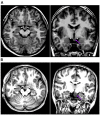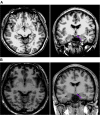Glucose Metabolism Characteristics of Extra-Hypothalamic Cortex in Patients With Hypothalamic Hamartomas (HH) Undergoing Epilepsy Evaluation: A Retrospective Study of 16 Cases
- PMID: 33519673
- PMCID: PMC7840884
- DOI: 10.3389/fneur.2020.587622
Glucose Metabolism Characteristics of Extra-Hypothalamic Cortex in Patients With Hypothalamic Hamartomas (HH) Undergoing Epilepsy Evaluation: A Retrospective Study of 16 Cases
Abstract
Purpose: There are few studies on the glucose metabolic characteristics of the extra-hypothalamic cortex in the hypothalamic hamartomas (HH). A comprehensive understanding of pathogenic progression of the disease is required from the perspective of cortical metabolism; therefore, we aimed to characterize metabolic characteristics of extra-hypothalamic in HH patients. Methods: We investigated the metabolic characteristics of 16 HH patients, all of whom underwent epilepsy evaluation at Xuan Wu Hospital between 2017 and 2019. The lateralization and cortical distribution pattern of hypometabolism was assessed and related to HH mass neuroanatomy on magnetic resonance imaging (MRI) as well as scalp-electroencephalogram (scalp-EEG) abnormalities. Furthermore, asymmetry measurements of region of interest (ROI) in the temporal cortex (hippocampal formation, amygdala, and lateral temporal neocortex) were quantitatively assessed based on the normalized average positron emission tomography (PET) voxel values. The surgery prognosis was assessed using the International League Against Epilepsy (ILAE) classification system. Results: The lateralization of hypometabolism in global visual ratings was consistent with the HH mass lateralization seen on MRI. Cortical hypometabolism showed three patterns depending whether the HH mass involved mammillary bodies, middle hypothalamus nucleus, or both. The three patterns were hypometabolism of the mesial temporal cortex with symptom of mesial temporal epilepsy (3/16, pattern I), lateral temporal, and extratemporal (frontal or parietal) cortex with symptom of neocortex temporal or frontal epilepsy (5/16, pattern II), and mesial and lateral temporal cortex and extratemporal (frontal or parietal) cortex with varied symptoms (8/16, pattern III), respectively. A significant difference in PET voxel values was found between bilateral hippocampal formation (P = 0.001) and lateral temporal neocortex in the third group (P = 0.005). We suggest that the hypometabolic characteristics of the extra-hypothalamic cortex in HH patients have three patterns. The final cortical hypometabolic pattern depends on the neuroanatomic location of the HH mass and was consistent with the main involved cortex of the interictal and ictal discharges. The third hypometabolic pattern with the most extensive cortical hypometabolism has a poorer prognosis.
Keywords: PET; epilepsy; extra-hypothalamic cortex; glucose metabolism; hypothalamic hamartomas.
Copyright © 2021 Yang, Wei, Meng, An, Fan, Wang, Wang, Ren, Shan and Zhao.
Conflict of interest statement
The authors declare that the research was conducted in the absence of any commercial or financial relationships that could be construed as a potential conflict of interest.
Figures







Similar articles
-
Positron emission tomography in epileptogenic hypothalamic hamartomas.Epileptic Disord. 2003 Dec;5(4):219-27. Epileptic Disord. 2003. PMID: 14975790
-
Reduced glucose metabolism in neocortical network nodes remote from hypothalamic hamartomas reflects cognitive impairment.Epilepsia. 2017 Jun;58 Suppl 2:41-49. doi: 10.1111/epi.13757. Epilepsia. 2017. PMID: 28591477
-
Extratemporal hypometabolism on FDG PET in temporal lobe epilepsy as a predictor of seizure outcome after temporal lobectomy.Eur J Nucl Med Mol Imaging. 2003 Apr;30(4):581-7. doi: 10.1007/s00259-002-1079-8. Epub 2003 Jan 30. Eur J Nucl Med Mol Imaging. 2003. PMID: 12557048 Clinical Trial.
-
Imaging and epilepsy.Brain. 1997 Feb;120 ( Pt 2):339-77. doi: 10.1093/brain/120.2.339. Brain. 1997. PMID: 9117380 Review.
-
Surgical treatment of West syndrome.Brain Dev. 2001 Nov;23(7):668-76. doi: 10.1016/s0387-7604(01)00305-9. Brain Dev. 2001. PMID: 11701275 Review.
Cited by
-
Advances in epileptic network findings of hypothalamic hamartomas.J Cent Nerv Syst Dis. 2024 Mar 5;16:11795735241237627. doi: 10.1177/11795735241237627. eCollection 2024. J Cent Nerv Syst Dis. 2024. PMID: 38449707 Free PMC article. Review.
-
Distinct gray matter and metabolic characteristics in hypothalamic hamartoma network with different semiology.Epilepsia. 2025 Aug;66(8):2853-2863. doi: 10.1111/epi.18438. Epub 2025 Apr 29. Epilepsia. 2025. PMID: 40299305 Free PMC article.
-
Advances in hypothalamic hamartoma research over the past 30 years (1992-2021): a bibliometric analysis.Front Neurol. 2023 Jun 6;14:1176459. doi: 10.3389/fneur.2023.1176459. eCollection 2023. Front Neurol. 2023. PMID: 37416311 Free PMC article.
-
Hypothalamic Hamartomas: A Narrative Review.Biomedicines. 2025 Feb 5;13(2):371. doi: 10.3390/biomedicines13020371. Biomedicines. 2025. PMID: 40002784 Free PMC article. Review.
References
LinkOut - more resources
Full Text Sources
Other Literature Sources

